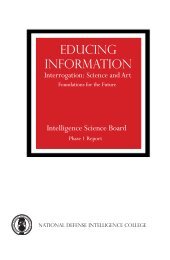COURTING A RELUCTANT ALLY - National Intelligence University
COURTING A RELUCTANT ALLY - National Intelligence University
COURTING A RELUCTANT ALLY - National Intelligence University
- No tags were found...
Create successful ePaper yourself
Turn your PDF publications into a flip-book with our unique Google optimized e-Paper software.
has held for an extensive period, such as the ONI correspondence files, there arecurrently no detailed finding aids developed for the NA’s newer acquisitions. Second,records are, for the most part, split along chronological lines at the NA.Materials dated prior to 1940 are housed in the Washington DC branch andrecords post-1940 are held at the College Park facility. Future researchers areadvised to work closely with a naval archivist to ascertain the location, scope, andavailability of the records at the NA.The Naval Academy Library also proved a good source of primary sourcematerial. In particular, the Library houses a special collections room which containsreminiscences of individuals, such as RADM Arthur H. McCollum, whoconducted the intelligence exchange visit to the UK in the late summer of 1941.In addition to providing information on this visit, McCollum’s reminiscences arefull of useful insights concerning the U.S. naval establishment during this period.Another significant source of information held at the Naval Academy is StrategicPlanning in the U.S. Navy: Its Evolution and Execution 1891-1945, a microfilmresource which contains many of the primary-source documents related to suchsignificant events as the Ingersoll Mission in 1938, the Standardization of ArmsTalks in 1940, and the American-British-Canadian (ABC-1) Staff Talks of 1941.The Library also houses bound collections of relevant primary-source materialrelated to foreign policy from the Office of the President, Franklin DelanoRoosevelt. In addition to documents related to U.S.-UK relations, these boundcollections contain correspondence between Roosevelt and his Secretary of theNavy, Frank Knox, and with the CNO during this period, ADM Stark, all ofwhich is helpful for understanding the ongoing dialogue between Roosevelt andhis advisors. These papers demonstrate how Roosevelt was committed to helpingGreat Britain for U.S. national security reasons, but they also reveal how large afactor domestic political constraints and the desire to retain equality with GreatBritain were in his decisionmaking. Additionally, the Library contains a completecollection of the State Department’s Foreign Relations of the United States. Thesecollections were instrumental for understanding some of the points of tensionbetween the two countries, such as colonialism, while also illuminating the factorsthat led to the strategic rapprochement between the two countries in the mid-1930s.Finally, The London Journal of General Raymond E. Lee, 1940-1941, editedby James Leutze and also found at the Naval Academy Library, can easily beoverlooked, but is an outstanding primary source for understanding this period.Lee was the Army attaché in London at the same time as Kirk, and his views ofthe situation offer a useful contrast with those provided by Kirk and others.104
















